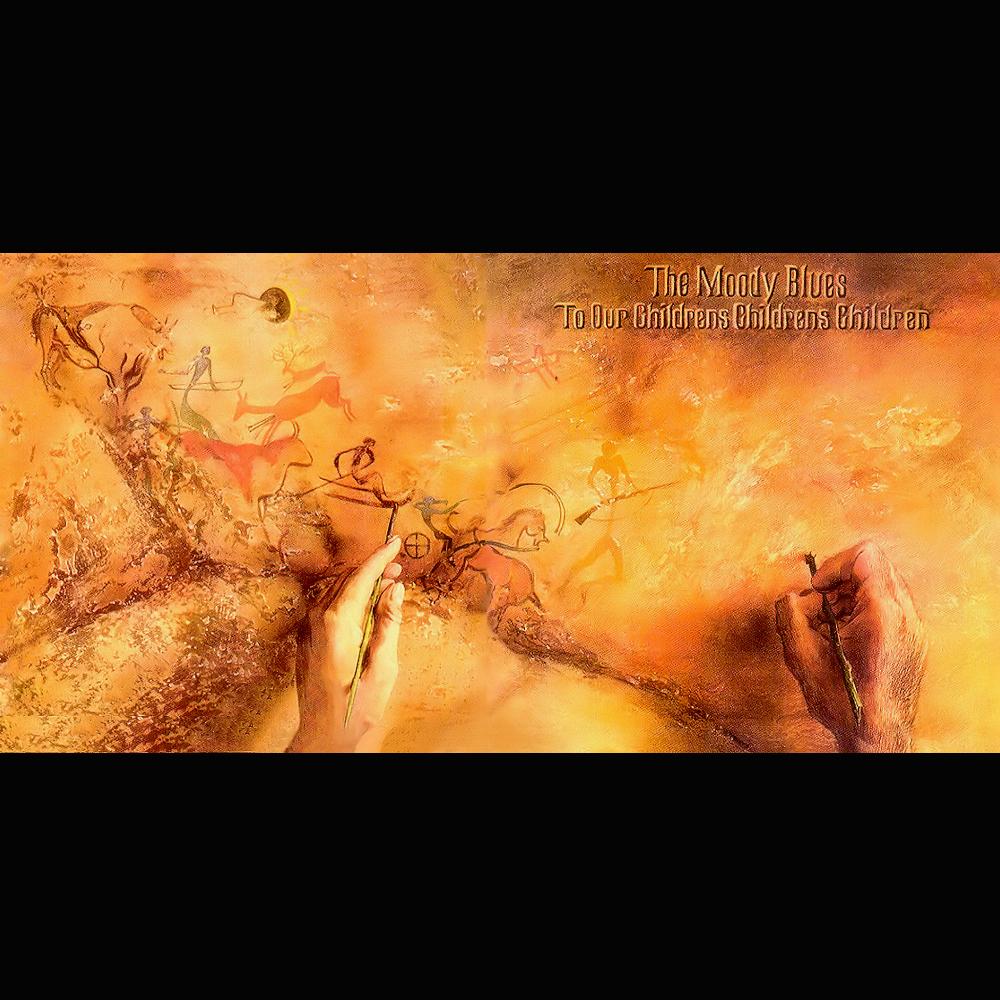
Album Information:
Album ID: 10195
About The Moody Blues:
The Moody Blues are an English rock band that formed in Birmingham, England in 1964. The original line-up consisted of vocalist and guitarist Denny Laine, drummer Graeme Edge, bassist Clint Warwick, keyboardist Mike Pinder, and vocalist and guitarist Ray Thomas. They were part of the British Invasion wave of bands that took over the American music scene in the mid-1960s.
The Moody Blues started off as a R&B band, but their sound evolved to be more psychedelic and progressive over time. They released their debut album 'The Magnificent Moodies' in 1965, which featured covers of R&B classics like 'You Really Got a Hold on Me' and 'Go Now'. The album was a success, reaching the top 30 in the UK and the top 100 in the US.
After Warwick left the band in 1966, the Moody Blues brought in bassist John Lodge and moved towards a more experimental sound. They released their second album 'Days of Future Passed' in 1967, which incorporated classical orchestration and featured the hit single 'Nights in White Satin'. The album was a critical and commercial success, and is now considered a classic of the progressive rock genre.
The Moody Blues continued to release successful albums throughout the 1970s, including 'On the Threshold of a Dream' (1969), 'A Question of Balance' (1970), and 'Seventh Sojourn' (1972). Their sound during this era was marked by lush orchestration, poetic lyrics, and philosophical themes.
In the late 1970s and early 1980s, the Moody Blues experimented with a more electronic sound and incorporated synthesizers into their music. They released albums like 'Octave' (1978) and 'Long Distance Voyager' (1981), which spawned hit singles like 'Gemini Dream' and 'The Voice'. Despite this new direction, the band's classic albums continued to be popular among fans and critics alike.
The Moody Blues underwent several lineup changes over the years, with Pinder leaving the band in 1978 and Laine departing in 1966. All of the original members except for Laine were inducted into the Rock and Roll Hall of Fame in 2018.
The Moody Blues have sold over 70 million records worldwide, making them one of the most successful bands in rock history. They continue to tour and perform their classic material to this day.
About the album To Our Childrens Childrens Children:
To Our Childrens Childrens Children is a progressive rock album by The Moody Blues, released in 1969. It's widely considered to be one of the band's finest works, featuring some of their most iconic songs and displaying a blend of progressive rock, orchestral arrangements, and psychedelic pop.
The album is conceptually based on the space race and the idea of humanity's journey to the stars, with a focus on environmentalism and the importance of preserving the earth for future generations. Its title is a reference to the idea that the album's themes are relevant not only to the children of the time, but also those of future generations.
The opening track, 'Higher and Higher,' sets the tone for the album with its soaring orchestral arrangement and lyrics about humanity's journey to the stars. The album features other notable tracks, such as 'Gypsy,' 'Out and In,' and 'Eternity Road,' all of which showcase the group's penchant for lush harmonies and thoughtful lyrics.
One of the album's standout tracks is 'Watching and Waiting,' which features a haunting vocal performance from Justin Hayward and lyrics about the importance of being present in the moment, rather than constantly looking towards the future.
Another highlight is 'Candle of Life,' which features a mesmerizing arrangement of soaring strings and horns, as well as a particularly emotive vocal performance from Hayward.
Overall, To Our Childrens Childrens Children is a classic album of its era, with a timeless message that's still relevant today. Its lush soundscapes, poetic lyrics, and sweeping orchestral arrangements make it a must-listen for fans of progressive rock and psychedelic pop.
Members:
The Moody Blues are an English rock band that formed in Birmingham, England in 1964. Since their inception, the lineup of the band has changed several times, with several key members contributing to the band's success over the years.
1. Graeme Edge - Born on March 30, 1941 in Rochester, England, Graeme Edge is the drummer and founding member of the Moody Blues. He wrote many of the band's early songs, including 'Departure' and 'Dr. Livingstone, I Presume.' Edge also had a successful solo career, releasing several albums and collaborating with other artists.
2. Justin Hayward - Born on October 14, 1946 in Swindon, England, Justin Hayward joined the Moody Blues in 1966 as a guitarist and vocalist. He is known for his distinctive singing voice and his songwriting contributions to the band, including hits like 'Nights in White Satin' and 'Your Wildest Dreams.' Hayward continues to tour and record with the band to this day.
3. John Lodge - Born on July 20, 1945 in Birmingham, England, John Lodge is the bassist and vocalist for the Moody Blues. He joined the band in 1966, and has been a key member ever since, contributing songs like 'Ride My See-Saw' and 'I'm Just a Singer (In a Rock and Roll Band).' Lodge has also released several solo albums and collaborated with other artists.
4. Michael Pinder - Born on December 27, 1941 in Birmingham, England, Michael Pinder was a founding member of the Moody Blues. He played keyboards and sang backup vocals for the band, and contributed many of their signature sounds, including the mellotron. Pinder left the band in 1978 to pursue a solo career in music.
5. Ray Thomas - Born on December 29, 1941 in Birmingham, England, Ray Thomas was a founding member of the Moody Blues. He played flute, saxophone, and harmonica for the band, and contributed to many of their early hits, including 'Go Now' and 'Nights in White Satin.' Thomas passed away in 2018 at the age of 76.
These five key members of the Moody Blues helped to create some of the most beloved and enduring music of the 1960s and beyond. Their contributions to the band's sound and legacy have made them one of the most influential and successful rock acts of all time.
Track List for To Our Childrens Childrens Children:
1. 'Higher and Higher' (4:07) - This opening track is a psychedelic instrumental piece with soaring guitar solos and an upbeat tempo.
2. 'Eyes of a Child I' (3:23) - This dreamy acoustic ballad is sung from the perspective of a child, with the gentle strumming of a guitar and the use of sound effects such as bird chirping and a ticking clock.
3. 'Floating' (3:02) - This ethereal song features a blend of orchestral instruments and rock instrumentation, with a chorus that invites the listener to 'float on a river of sound'.
4. 'Eyes of a Child II' (1:20) - This short interlude features a choir of children singing a simple melody, adding to the childlike theme of the album.
5. 'I Never Thought I'd Live to be a Hundred' (1:06) - This whimsical, spoken-word piece invites the listener to imagine what they would do if they lived to be one hundred years old. It features playful sound effects such as the ticking of a clock and laughter.
6. 'Beyond' (2:58) - This mystical song is driven by a haunting organ melody and surreal lyrics about exploration of the unknown.
7. 'Out and In' (3:47) - This upbeat track features a catchy guitar riff and lyrics about the cyclical nature of life.
8. 'Gypsy' (3:33) - This romantic ballad is full of lush guitars and a beautiful vocal performance by lead singer Justin Hayward.
9. 'Eternity Road' (4:19) - This introspective track features intricate guitar work and philosophical lyrics about the quest for eternal truth.
10. 'Candle of Life' (4:14) - This uplifting song features soaring harmonies and lyrics about the power of hope and love.
11. 'Sun is Still Shining' (3:40) - This jangly folk tune has uplifting lyrics about perseverance and finding positivity in life.
12. 'I Never Thought I'd Live to be a Million' (0:33) - This brief, light-hearted piece features whimsical lyrics and a mock serious delivery.
13. 'Watching and Waiting' (4:16) - This lush, orchestral ballad is a fan-favorite, with beautiful vocal harmonies and lyrics about the infinite mysteries of life.
Overall, To Our Childrens Childrens Children is a concept album full of surreal, philosophical lyrics and dream-like instrumentation. It reflects the era in which it was created (1969), with its use of psychedelic and folk influences, as well as its message of hope, love, and exploration of the unknown.
Discography for The Moody Blues:
Here's a complete discography for The Moody Blues, in chronological order:
1. The Magnificent Moodies (Album, 1965)
2. 'Go Now!' (Single, 1964)
3. 'From The Bottom of My Heart (I Love You)' (Single, 1965)
4. 'Everyday' (Single, 1965)
5. 'I Don't Want To Go On Without You' (Single, 1965)
6. 'Boulevard de la Madeleine' (Single, 1967)
7. Days of Future Passed (Album, 1967)
8. 'Nights In White Satin' (Single, 1967)
9. 'Tuesday Afternoon' (Single, 1968)
10. In Search of the Lost Chord (Album, 1968)
11. 'Voices In The Sky' (Single, 1968)
12. 'Ride My See-Saw' (Single, 1968)
13. 'Watching and Waiting' (Single, 1969)
14. On The Threshold Of A Dream (Album, 1969)
15. 'Never Comes The Day' (Single, 1969)
16. 'Question' (Single, 1970)
17. 'A Simple Game' (Single, 1970)
18. To Our Children's Children's Children (Album, 1969)
19. 'Melancholy Man' (Single, 1970)
20. 'Procession' (Single, 1971)
21. 'The Story In Your Eyes' (Single, 1971)
22. Every Good Boy Deserves Favour (Album, 1971)
23. 'Isn't Life Strange' (Single, 1972)
24. Seventh Sojourn (Album, 1972)
25. 'I'm Just A Singer (In A Rock And Roll Band)' (Single, 1972)
26. 'Steppin' In A Slide Zone' (Single, 1978)
27. Octave (Album, 1978)
28. 'Driftwood' (Single, 1978)
29. 'The Voice' (Single, 1981)
30. Long Distance Voyager (Album, 1981)
31. 'Gemini Dream' (Single, 1981)
32. 'The Other Side Of Life' (Single, 1986)
33. The Other Side Of Life (Album, 1986)
34. 'Your Wildest Dreams' (Single, 1986)
35. 'I Know You're Out There Somewhere' (Single, 1988)
36. Sur la Mer (Album, 1988)
37. A Night at Red Rocks with the Colorado Symphony Orchestra (Live Album, 1993)
38. 'Say It With Love' (Single, 1991)
39. Keys of the Kingdom (Album, 1991)
40. 'Say What You Mean' (Single, 1991)
41. 'English Sunset' (Single, 1999)
42. Strange Times (Album, 1999)
43. December (Album, 2003)
44. Lovely to See You: Live (Live Album, 2005)
45. 'The Very Best of The Moody Blues' (Compilation Album, 1996)
Note: This list does not include any unauthorized or unofficial releases.


 Last Played: 11/01/24 04:15 AM
Last Played: 11/01/24 04:15 AM Last Played: 11/01/24 04:12 AM
Last Played: 11/01/24 04:12 AM